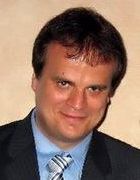
Prof. Dr.-Ing. Darius Burschka
Academic Career and Research Areas
Prof. Burschka (b. 1966) conducts research into sensor systems in robotics and human-machine interfaces. Video-based navigation is one of his particular interests. This involves simulation of complex sensor systems through the analysis and fusion of sensor properties of physical sensor units and 3D reconstruction from the fusion of multimodal sensor data.
After completing his studies in electrical engineering and his doctorate (1998) at TUM, Prof. Burschka became a postdoctoral researcher at Yale University, New Haven, USA. There, he made advancements in the development of laser-based map generation and position tracking. After that, he worked as an associate research scientist at Johns Hopkins University, Baltimore, USA. His research topic was sensor-based navigation and 3D reconstruction (1999-2005). He was appointed assistant research professor at the university in 2003. Since 2005, Prof. Burschka has held the position of associate professor of robotics and embedded systems at TUM. He works closely with the Institute for Robotics and Mechatronics of the German Aerospace Center (DLR) in Oberpfaffenhofen.
Awards
- Airtec 2010 Silver Award for DLR-TUM cooperation (2010)
- Best paper award from Intelligent Vehicles Conference 2010 in cooperation with BMW AG (2010)
- Best paper finalist IROS (Robotics) 2003 and 2009
- Best paper award from the MICCAI (Medicine) 2005
Key Publications
Mair E, Hager GD, Suppa M, Burschka D: “Adaptive and Generic Corner Detection Based on the Accelerated Segment Test.” Computer Vision. European Conference on Computer Vision ECCV 2010. 2010; 6312: 183-196.
AbstractBurschka D, Mair E: “Direct Pose Estimation with a Monocular Camera”, Robot Vision 2008, Lecture Notes in Computer Science. 2008; 4931: 440-453.
AbstractBurschka D, Li M, Taylor R, Hager GD, Ishii M: “Scale-Invariant Registration of Monocular Endoscopic Images to CT-Scans for Sinus Surgery”. Medical Image Analysis. 2005; 9(5):413-439.
AbstractBurschka D, Hager GD: “V-GPS - Image-Based Control for 3D Guidance Systems”. Proc. of IROS. 2003: 1789-1795.
AbstractBrown MZ, Burschka D, Hager GD: “Advances in Computational Stereo”. IEEE Transactions on Pattern Analysis and Machine Intelligence. 2003; 25(8):993-1008.
AbstractIf you wish your profile to be changed or updated please contact Franz Langer.